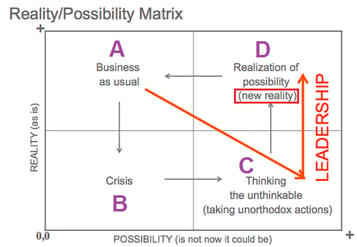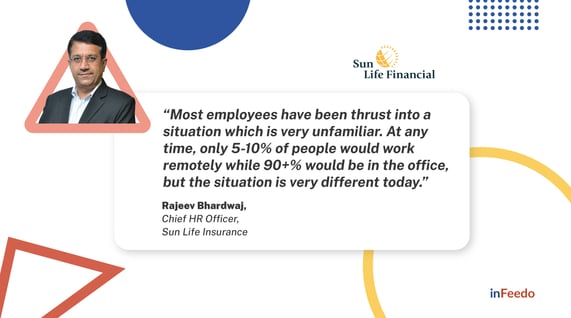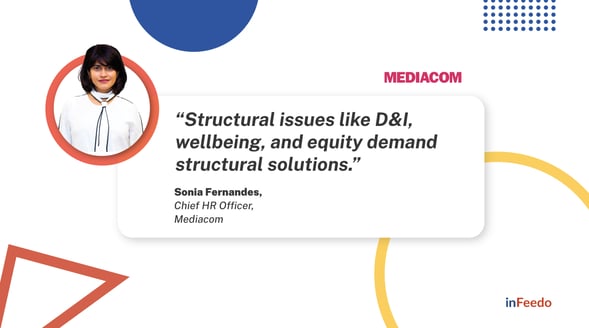6 min read
5 Takeaways from People-First Leaders on Promoting HR Agility
Akanksha Tanwar
Last Updated: 3 February 2023
In this article:
I think we can all agree that the 2020 workplace is as unique and unprecedented as it gets. Being caught without warning and forced into a completely unprecedented style of working raised several logistical and procedural changes for employees and HR departments alike, but also presented us with a unique opportunity to adapt, improvise, and evolve! The key focus of almost all of our pandemic efforts? HR agility.
We were proud to host Tanmaya Jain, CEO inFeedo, Sonia Fernandes, CHRO MediaCom, and Rajeev Bhardwak, CHRO Sun Life Insurance for an HR power panel on the three key tenets of the 2020 workplace: Innovation, Agility, and Productivity.
WATCH THE FULL SESSION HERE:
Here are our top 5 takeaways from this killer panel:
1. Keep Reinventing Engagement with Technology to Foster Agility in the Workplace
Before the outbreak of the COVID-19 pandemic there were already discussions about the future of the gig economy and decentralized or completely remote workforces, but this drastic disruption has put these conversations on fast forward and necessitated agility. Fortunately, Rajeev and Sonia have both utilized Amber, our AI chatbot and employee engagement platform, to keep up with an ever-changing world of work. New technologies can help us overcome many of the challenges we now face as a result of remote work, like communication gaps and morale related issues, as our people leaders have proved with their successes at inFeedo, MediaCom, and Sun Life Insurance! “We are a 150-year-old insurance company and our process have always been centered on connecting with the client one on one. But that has come to a total standstill over the course of the last 3-4 months. So we came out with a virtual office where a client can reach out and ask questions without interacting in person!,” said Rajeev.
Organizations being driven by both external and internal stimuli should focus on both employees and customers to talk the language that resonates with them, and tech is the best way to drive this. Adding to the same narrative, Sonia shared her experience with Amber and how it has fostered HR agility; ”We were faced with a crisis in terms of driving engagement at work and Amber solved that beautifully for us. Now we look forward to scaling the solution and driving more impact because it resonates with our people who have been very receptive towards it.”
Further Reading:
2. Harness a Crisis to Think Outside the Box and Ensure Remote Agility During COVID-19

Agile innovation while working remotely can only be driven from the ground up. While building HR agility is a key focus area for HR teams worldwide, ensuring it’s an organization wide focus and agenda item ensures high buy-in levels. Tanmaya shared this awesome reality-possibility matrix to help us understand the topic a bit better, listen to him explain in-depth in the full recording; you don’t want to miss it! In his own words, “A crisis actually forces you to do the unthinkable and realize there is a possibility out of that.” During BAU a large enterprise might have no way to drive agility and innovation in the whole unit. So having teams focused on experimentation and learning from failure can work wonders. “This team is okay with failure. Because ironically, it is the crisis of failure that forces you to innovate,” Tanmaya added.
What does that mean for you in your pursuit of HR agility? Simple: take risks. Hopefully you’re working at an organization that encourages outside the box thinking and creative problem solving, because if there’s one trait we should be harnessing and cultivating right now it’s ingenuity. With everything, and I mean everything, up in the air there’s no better time to roll up your sleeves and try a new approach to an old problem. As long as you’re documenting your processes and learnings, even in the event of failure, it’s a valuable endeavor. We learn as much, if not more, from the experiments that go wrong than the ones that go right. So get out there, create some outside the box hypotheses, and start putting them to the test!
3. Practice Radical Candor to Foster Employee Growth with Constructive Feedback
.png?width=336&name=pasted%20image%200%20(1).png)
There’s nothing worse than unconstructive negative feedback. All it does is foster irritation, further preexisting disconnects, and create the kind of chasms that can eventually drive a high-performing employee out of an organization. The second worst thing might be useless fluff feedback that contains no real kernels of insight and fails to highlight any key areas for growth. We all like a pat on the back, but if it’s inauthentic and merely obfuscates key areas of concern then it’s actually a disservice to us because it provides no drive for change or improvement!
So, should we objectively and constructive challenge our peers directly or should we consistently empathize with and support them? Well, why not both! Radical Candor is the sweet spot between obnoxious aggression and ruinous empathy. By achieving a balance of the two a manager can both simulate their team members intellectually while understanding their emotions and practicing active empathy. It’s the best way to drive innovation and improve employee experience because empathy and agility are two key levers in establishing an employee-first organizational culture.
4. Prioritize Teaching Empathy to Keep Mental Health Levels High during Crisis

“Most of the employees have been thrust into a situation which is very unfamiliar. At any time, only 5-10% of people would work remotely while 90+% would be in the office, but the situation is very different today,” shared Rajeev. We didn’t volunteer to work from home, but it’s a reality of current circumstances and the socially responsible thing to do. An unfortunate consequence of this drastic and breakneck change is a lot of employees don’t have conducive setups for success at home. A high stress, low control environment like many of our homes demands new and better coaching methods for the managers to develop the necessary hard and soft skills. Productivity is a direct outcome of both mental and physical aspects of an employee’s health, and a culture of organizational transparency. In times like this a renewed focus on employee wellbeing, cultural transparency, and cadence of regular communication is key.
As Asia is a high touch, high context system, the engagement styles, and coping mechanisms found here are very different. “There can be nothing called over communication in a scenario like this because you never know when someone is picking it up,” Rajeev added. So what does that mean for you? If you’re feeling something, talk about it! Proactively raising concerns rather than allowing them to fester is a crucial way to ensure both personal and professional growth. Hopefully your organization is fostering a culture of transparency and empathy where concerns are heard and respected. If you’re an HRBP you can be a huge part of that cultural shift by making the workspace safe for everyone to say what they’re feeling without fear of ramifications. Living in fear that personal concerns, or mental health issues, will negatively impact your colleagues’ or employers’ perception of you is incredibly detrimental to employee wellbeing, so make sure you’re practicing HR agility and transitioning to a culture of empathy.
5. Hold Every Leader Accountable to Ensure Diversity and Inclusion, and Drive Agility and Innovation in the Workplace

HR’s efforts to facilitate diversity and inclusion, employee wellbeing, and agile thinking are well documented, but they’re obviously difficult topics to crack. So what have our participants focused on? In Sonia’s eyes, “Structural issues like D&I, wellbeing, and equity, demand structural solutions.” When presented with a unique and unprecedented situation like this, we must remember to build on the work done on the diversity and inclusion front so far. Every single person from the leadership to the last employee in the corporate hierarchy is responsible when it comes to facilitating inclusion at work. If buy-in isn’t universal, then there’s no point in promoting it to begin with. It only takes a few detrimental voices to drag down collective efforts, so ensuring all members of your organization are exposed to a variety of opinions and perspectives, as well as attending prerequisite training sessions, is the best way to ensure your hard work doesn’t go to waste.
A lot of people feel that fostering inclusive environments is simply window dressing or done for the sake of appearances, but our leaders were unequivocal in their affirmation that diversity strategies aren’t just diversity strategies, they are business strategies. It’s simple. Having an organization where 100% of employees feel respected and empowered enough to perform to the best of their abilities will result in 100% outputs. If 10% of employees feel unsafe or like they’re not respected, that’s going to detract from your outputs. With that, and common decency, in mind, zero tolerance to any kind of discrimination should permeate all hiring, training, and career progression initiatives. All of these efforts lead to higher retention in the organization and prevent talent loss by as much as 82% high flight risk people as observed in the case of MediaCom. “Amber’s innovation-driven services, along with our D&I framework have had a huge role to play,” shared Sonia.
The raw passion and personal anecdotes about difficulties faced in the workplace shared by our panelists blew us away. Honesty and transparency are tenets all organizations should subscribe to, and it’s abundantly clear that Rajeev and Sonia have put them in place at their organizations. So cheers to our employee-first leaders of the future; the time to reinvent the modern workplace is here.
WATCH THE FULL SESSION HERE:
Embrace people-led change in your enterprise with this first step
You may opt-out at any time. Privacy Policy

